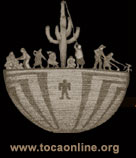

 |

|
 Tohono O'odham Community Action (TOCA) is a grass-roots organization working to reduce diabetes and improve the health of residents by encouraging ties to traditional culture. ARTICLES See resources related to this case study » Download lesson plan related to this case study: PDF or Word Diet and exercise do matter, but as Dr. Warne and leading Native American health scholar Bonnie Duran point out, they have to be viewed within the context of people’s real lives: what foods are available, socioeconomic status, power and control over one’s future, and resources to cope with stress and upheaval. For indigenous groups, the legacy of past injustices, genocide, displacement, paternalistic federal policies, and cultural and economic loss makes this an especially complicated issue. Anthropologist Mariana Ferreira believes that we need a radical shift in the way we define diabetes. She argues that for groups like the O’odham, the trauma of historical events, combined with continuing inequities, produces a chronic stress response which, over time, weakens the body’s immune system, heightens blood-sugar levels and results in the overproduction of adrenaline, cortisol and other hormones related to diabetes. Dr. Ferreira’s historical trauma hypothesis is controversial, but the effects of chronic stress have been well documented by other researchers. Under normal conditions, the body’s physiological response to stress is a natural coping mechanism when confronted with anxiety, fear and a physical threat. But when the stress response can’t be turned off, it can take a toll on the body. Susceptibility to illness increases when the body is in a constant state of defense. Similar patterns of chronic disease have been observed in other dispossessed peoples in far-flung corners of the world. Dr. Warne adds that today, poverty, racism, lack of opportunity, inadequate government services and self-blame (arising from the conventional notion of diabetes as a “lifestyle” issue) are concrete sources of stress and dysfunction within Indian communities that partially explain the fatalism with which many Native Americans view the disease: “People don’t start home gardens and join the health club when their basic needs are not being met, when they are worried about where their next meal will come from, or when they feel that have nothing to live for.” Moreover, Native Americans are getting mixed messages from health care specialists. As the American Diabetes Association points out, solving the diabetes epidemic is good for all of us: nationwide costs from 2007 are calculated at $174 billion, increasing an average of over $8 billion per year since 2002. Health economists estimate that if preventive measures were enacted on a wide scale, taxpayers could save as much as $30 billion over 10 years. Yet diabetes treatment is a multi-billion-dollar business: drug companies, dialysis centers, hospitals that perform amputations and treat complications, and manufacturers of medical equipment all turn a tidy profit. “It’s almost as though the system encourages people to get sick and then people get paid to treat them,” says Matthew Fink, former president of Beth Israel Hospital in Boston. Dr. Warne adds that “There’s something wrong with a system that will tell American Indians we won’t spend $40,000 to hire a P.E. teacher when you’re young, but when you are older, we will spend hundreds of millions of dollars to filter your blood through dialysis, amputate your limbs, get you a wheelchair, or fit you with prosthetics.” Whatever the ultimate explanation for their diabetes, it’s clear that the O’odham and other Native peoples need long-term, health-promoting strategies that go beyond admonishments to eat better and get proper exercise. As Dr. Warne reminds us, this will likely require both community-based initiatives to strengthen and empower individuals and public policy interventions that make good on long-overdue obligations and restore tribal sovereignty. |
|
|||
|